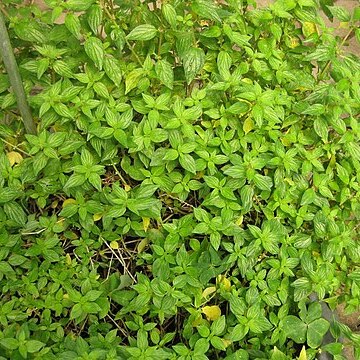Monoecious or dioecious, annual or perennial herbs, shrubs or small trees, pubescent, without irritant hairs. Leaves alternate or opposite, the upper leaves sometimes grading into bracts, petiolate or sessile (not in Australia), chartaceous, 3-veined; stipules free, sometimes caducous, or fused (not in Australia). Inflorescence small axillary clusters (sometimes spike-like when subtended by modified bract-like leaves). Male flowers: tepals 3–5; stamens 3–5; pistillode present. Female flowers: perianth tubular; orifice contracted, usually 2–5-toothed; ovary enclosed by perianth; stigma linear, short or long, short-papillose, often caducous. Fruiting perianth often ribbed or winged. Achene shiny, fawn, brown, black or white, enclosed by but not attached to fruiting perianth, which is finally detached, releasing the achene.
Erect annual or, more often, perennial herbs or shrubs, monoecious. Leaves alternate, opposite or verticillate, petiolate or sessile, entire or dentate, cystoliths dot-like; stipules free, lateral. Inflorescence of compact axillary bisexual glomerules. Male flowers pedicellate, 4–5-merous; tepals rarely with transversal crests or wings; rudimentary ovary present or absent. Female flowers sessile, with an indefinite number of completely fused tepals enclosing the ovary, sometimes apparently fused with it in the lower part, often with ± clearly marked longitudinal ridges or wings; staminodes absent; stigma sessile, filiform with lateral papillae, deciduous. Achene ovoid, erect, ± compressed, completely enclosed in the persistent membranous perianth.
Herbs or subshrubs [and shrubs], perennial, with nonstinging hairs. Stems simple, erect. Leaves alternate, less often opposite; stipules present. blades elliptic, lanceolate, or ovate, margins entire; cystoliths rounded. Inflorescences axillary. Flowers unisexual, staminate and pistillate flowers in sessile or subsessile clusters in same inflorescences; bracts oblanceolate, lacking hooked hairs. Staminate flowers: tepals 4, equal; stamens 4; pistillode present. Pistillate flowers: tepals 4, connate, appressed to and tightly enclosing ovary; staminodes absent; style deciduous, elongate. Achenes ovoid, acute, not mucronate, tightly enclosed by persistent tepals. x = 13.
Low shrubs, rarely woody vines; stipules free, often persistent; leaves alternate (in American species), entire or rarely toothed; petiolate, trinerved, densely covered with punctiform cystoliths above; plants usually monoecious, the flowers in small clusters, in the leaf axils or forming spikes; staminate perianth depressed-globose in bud, 3-5-parted or-lobed, the stamens 3-5; pistillate perianth tubular, contracted at the throat, 2-4 toothed, completely enclosing the ovary, strongly nerved, the stigma pubescent on one side, the achenes crustaceous, shiny.
Female flowers sessile, with an indefinite number of completely fused tepals which enclose the erect ovaries; staminodes absent; stigma sessile, filiform with lateral papillae, deciduous.
Male flowers pedicellate, 4–5-merous, tepals rarely with transverse crests or wings, ovaries rudimentary or absent.
Leaves alternate, opposite or verticillate, petiolate or sessile, entire or dentate; stipules free, lateral.
Achene ± compressed ovoid, completely enclosed in the persistent membranaceous perianth.
Inflorescences of compact, axillary bisexual glomerules.
Erect annual or perennial herbs, or shrubs, monoecious.
Cystoliths dot-like.

